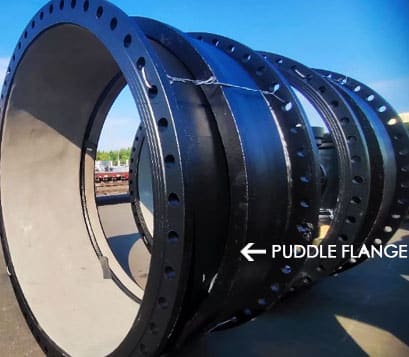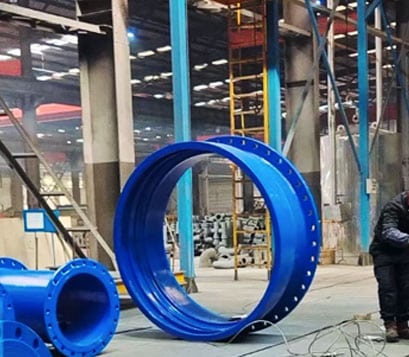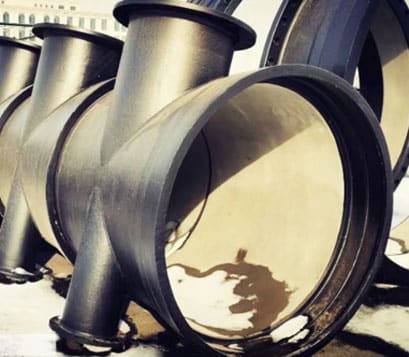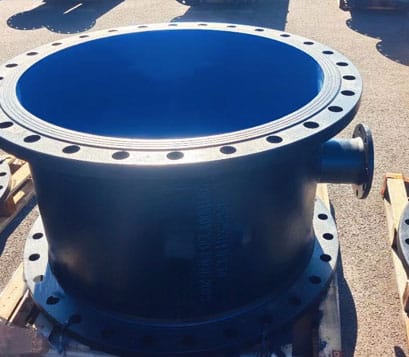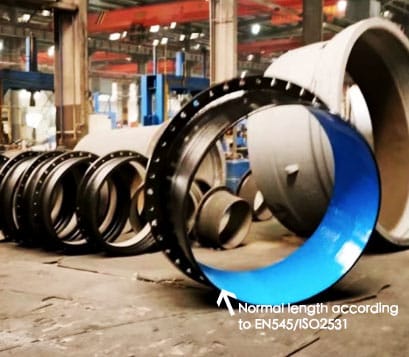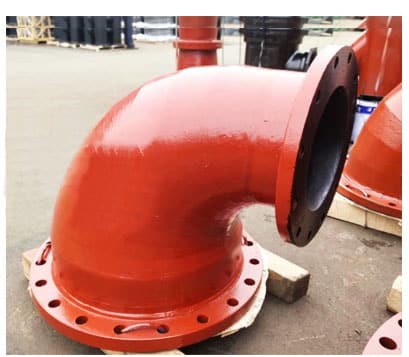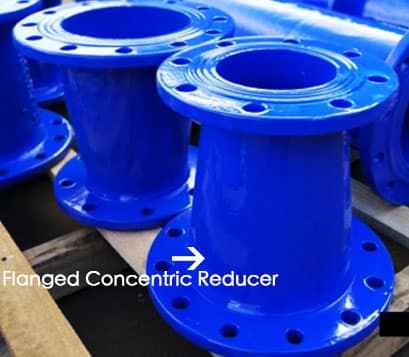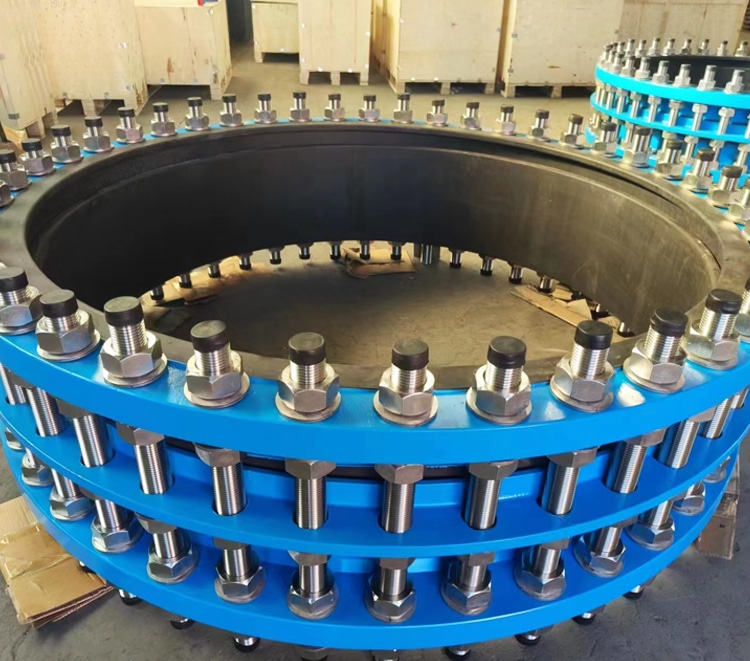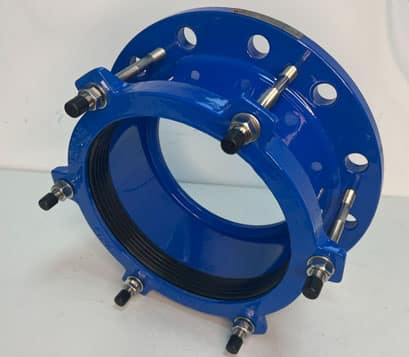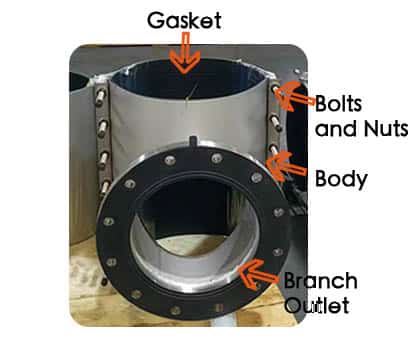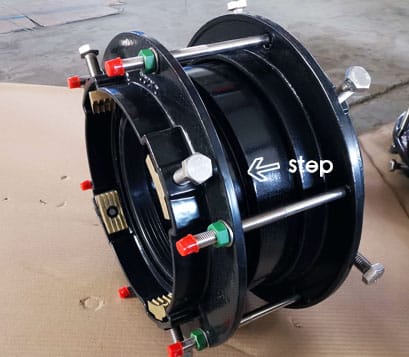FLANGED FITTINGS
Flanged fittings are components used in piping systems to connect pipes, valves, pumps, and other equipment, allowing for easy assembly and disassembly. The key feature of flanged fittings is the flange, a protruding rim or edge, that is bolted together to create a secure, leak-proof joint.
Flanged fittings are designed to provide a strong, reliable connection in a piping system. They are commonly used in applications where pipes need to be frequently assembled and disassembled or where the connection must withstand high pressure and temperature.
Judberd can offer many different ductile iron flanged fittings ,include but not limited as below
Ductile Iron Flanged Fittings Design standard and Dimensions
The design of ductile iron flanged fittings is governed by several standards to ensure that they meet the necessary mechanical, dimensional, and performance requirements. Here are the key design standards and the critical aspects they cover:
ANSI/AWWA Standards
- AWWA C110
Title: Ductile-Iron and Gray-Iron Fittings for Water
Scope: Specifies the requirements for ductile iron and gray iron fittings with flanges for water systems.
Dimensions: Provides detailed dimensions for different types of fittings, including tees, bends, reducers, and flanges.
Pressure Ratings: Standard pressure ratings typically range from Class 150 to Class 350.
Materials: Specifies material properties, including tensile strength, yield strength, and elongation.
Testing: Includes requirements for hydrostatic pressure tests, dimensional checks, and coating specifications.
- AWWA C115
Title: Flanged Ductile-Iron Pipe with Ductile-Iron or Gray-Iron Threaded Flanges
Scope: Covers flanged ductile iron pipes with threaded flanges.
Design: Specifies the design criteria for threading, welding, and the application of flanges.
Pressure Ratings: Similar to AWWA C110, with detailed requirements for pressure testing.
- AWWA C153
Title: Ductile-Iron Compact Fittings for Water Service
Scope: Focuses on compact fittings, which are smaller and lighter than those covered by C110.
Dimensions: Provides dimensional standards for compact fittings, ensuring compatibility and ease of installation.
Materials and Testing: Similar to C110, with specific requirements for material properties and testing procedures.
ISO Standards
- ISO 2531
Title: Ductile Iron Pipes, Fittings, Accessories, and Their Joints for Water or Gas Applications
Scope: International standard covering a wide range of ductile iron components.
Design and Dimensions: Specifies dimensions for pipes and fittings, including flanged connections.
Pressure Ratings: Defines pressure classes and the associated design requirements.
Materials: Details material specifications, including mechanical properties and chemical composition.
Testing: Includes requirements for hydraulic testing, coating, and inspection.
- ISO 7005-2
Title: Metallic Flanges – Part 2: Cast Iron Flanges
Scope: Covers the design and dimensions of cast iron flanges, including those made from ductile iron.
Dimensions: Specifies flange dimensions, including bolt hole sizes and spacing.
Pressure Ratings: Defines pressure ratings for different flange classes.
Materials and Testing: Similar to ISO 2531, with detailed requirements for material properties and testing.
EN Standards (European Norms)
- EN 545
Title: Ductile Iron Pipes, Fittings, Accessories, and Their Joints for Water Pipelines
Scope: European standard for ductile iron water pipeline components.
Design and Dimensions: Provides detailed dimensions for fittings and flanges.
Pressure Ratings: Specifies pressure classes and design criteria.
Materials: Defines material properties, including tensile strength and ductility.
Testing: Includes hydrostatic testing, coating requirements, and inspection protocols.
- EN 598
Title: Ductile Iron Pipes, Fittings, Accessories, and Their Joints for Sewerage Applications
Scope: Similar to EN 545 but specifically for sewerage systems.
Design and Dimensions: Ensures compatibility with sewerage system requirements.
Pressure Ratings and Materials: Similar to EN 545, with specific requirements for sewerage applications.
Testing: Includes additional testing for corrosion resistance and durability in sewerage environments.Inc
AS/NZS Standards (Australian/New Zealand Standards)
AS/NZS 2280
Title: Ductile Iron Pipes and Fittings
Scope: This standard specifies requirements for ductile iron pipes, fittings, accessories, and their joints for water supply and wastewater systems in Australia and New Zealand.
Design and Dimensions: Provides detailed dimensions for ductile iron fittings, including flanged fittings, ensuring compatibility and proper fit.
Pressure Ratings: Specifies pressure classes and the associated design requirements, typically covering PN 16, PN 21, and PN 35 pressure ratings.
Materials: Defines the material properties required for ductile iron, including mechanical properties such as tensile strength, yield strength, and elongation.
Coating and Linings: Specifies requirements for internal linings (e.g., cement mortar) and external coatings (e.g., zinc and bitumen) to protect against corrosion and ensure long-term durability.
Testing: Includes requirements for hydrostatic pressure testing, coating adherence tests, and other quality control measures to ensure the reliability and safety of the fittings.
Marking: Specifies the information that must be marked on the fittings, including manufacturer’s name, pressure rating, size, and standard compliance.
Joint Types: Covers various types of joints used with ductile iron fittings, including flanged joints, push-fit joints, and restrained joints.
Design Considerations
- Material Properties
Ductile iron must meet specific mechanical properties, including tensile strength, yield strength, and elongation. These properties ensure that the fittings can withstand internal pressures and external forces without failure.
- Pressure Ratings
Fittings are designed to operate under specific pressure ratings, typically ranging from Class 150 to Class 350 or higher. These ratings ensure that the fittings can handle the maximum pressure expected in the system.
- Dimensions and Tolerances
Standards provide detailed dimensional specifications for different types of flanged fittings. These dimensions include flange diameter, bolt hole size and spacing, and overall fitting size.
- Coating and Corrosion Protection
Fittings are often coated to prevent corrosion. Standards specify the type and thickness of coatings, such as epoxy or zinc coatings, to ensure long-term durability.
- Testing and Quality Control
Standards require various tests to ensure the quality and reliability of ductile iron flanged fittings. These tests include hydrostatic pressure tests, dimensional checks, and material inspections.
By adhering to these standards, manufacturers ensure that ductile iron flanged fittings are reliable, compatible with other system components, and suitable for the intended application.
Ductile Iron Flanged Design standard and Dimensions
Design Standards for Ductile Iron Flanges
Common Standards
EN 545 (Ductile Iron Fittings for Water Pipes)
Corresponding Flange Standard: EN 1092-2
EN 1092-2: Cast Iron Flanges
Includes dimensions, materials, pressure classes, and testing requirements for flanges.
EN 598 (Ductile Iron Fittings for Sewerage Pipes)
Corresponding Flange Standard: EN 1092-2
Likewise, cast iron flanges for sewerage pipes ensure the durability and reliability of flanges in sewerage applications.
ISO 2531 (Ductile Iron Pipes and Fittings)
Corresponding Flange Standard: ISO 7005-2
ISO 7005-2: Metallic Flanges – Part 2: Cast Iron Flanges
Includes dimensions, materials, pressure classes, and testing requirements for flanges.
AS/NZS 2280 (Australian/New Zealand Standard)
Corresponding Flange Standard: AS4087
ANSI/AWWA C110/C115/C153 (American Water Works Association Standards)
Corresponding Flange Standard: ANSI B16.1
ANSI B16.1: Cast Iron Pipe Flanges and Flanged Fittings
Includes dimensions, materials, pressure classes, and testing requirements for flanges.
Key Design Elements
Dimensions and Tolerances
Flange Diameter: Outer, inner, and bolt circle diameters.
Thickness: Flange thickness and hub dimensions.
Bolt Holes: Number, size, and spacing of bolt holes.
Pressure Class
Standards typically cover pressure classes from PN 6 to PN 40, depending on the application.
Different pressure classes correspond to different design and testing requirements.
Material Specification
Chemical composition and mechanical properties of ductile iron, including tensile strength, yield strength, and elongation to ensure the durability, strength, and corrosion resistance of materials.
Surface Finish
Surface finish requirements for flange sealing faces to ensure good sealing and prevent leaks.
Marking
Marking requirements on flanges per standard, including manufacturer’s name, pressure class, size, and standard compliance.
Testing and Quality Control
Includes pressure testing, dimension inspection, and non-destructive testing requirements to ensure flanges meet specified quality standards.
Typical Dimensions and Pressure Classes
Here are some typical flange dimensions and pressure classes for the key standards:
EN 1092-2
Nominal Diameter (DN): Typically ranging from DN 10 to DN 4000
Pressure Class: PN 6, PN 10, PN 16, PN 25, PN 40
Flange Thickness: Varies with diameter and pressure class
Bolt Circle Diameter: Specified for each nominal diameter and pressure class
Number and size of bolt holes: e.g., DN 50 flanges have 4 bolt holes, DN 600 flanges have 20 bolt holes
ISO 7005-2
Nominal Diameter (DN): Typically ranging from DN 10 to DN 4000
Pressure Class: PN 6, PN 10, PN 16, PN 25, PN 40
Flange Thickness: Varies with diameter and pressure class
Bolt Circle Diameter: Specified for each nominal diameter and pressure class
Number and size of bolt holes: e.g., DN 40 flanges have 4 bolt holes, DN 2000 flanges have 48 bolt holes
ANSI B16.1
Nominal Diameter (inches): From 1/2 inch to 48 inches
Pressure Class: Class 125, Class 250
Flange Thickness: Varies with diameter and pressure class
Bolt Circle Diameter: Specified for each nominal diameter and pressure class
Number and size of bolt holes: e.g., 2-inch flanges have 4 bolt holes, 24-inch flanges have 20 bolt holes
Conclusion
By following these design standards, manufacturers can ensure the reliability, compatibility, and suitability of ductile iron flanges to meet various industrial requirements, providing durable, leak-free joint solutions. The correspondence between various standards helps in selecting the appropriate flange for different applications, enhancing the safety and reliability of systems.manufacturers can ensure the reliability, compatibility, and suitability of ductile iron flanges to meet various industrial requirements, providing durable, leak-free joint solutions.
Flanged Fittings Application
Flanged pipe fittings made of different materials are suitable for different applications due to their unique physical and chemical properties. Here are common materials of flanged pipe fittings and their typical applications:
1.Ductile Iron
Applications:
Water treatment and supply systems: Suitable for urban water distribution networks and rural water supply systems because of good corrosion resistance and strength.
Sewage and wastewater treatment: Widely used in sewage treatment plants and sewer pipes to resist corrosive substances in sewage.
Fire protection systems: Used for fire hydrants and fire water pipes to withstand high-pressure water flows.
2. Stainless Steel
Applications:
Food and beverage industry: Suitable for food processing, brewing, dairy production, etc., due to high corrosion resistance and non-toxicity.
Chemical and pharmaceutical industry: Used to handle corrosive chemicals and drugs to ensure system cleanliness and corrosion resistance.
Marine engineering: In environments like seawater desalination and offshore platforms due to excellent resistance to saltwater corrosion.
3. Carbon Steel
Applications:
Oil and gas industry: Suitable for oil refineries, natural gas pipelines, etc., because of high strength and pressure resistance.
Power industry: Used in power plants for cooling water systems, steam pipes, etc.
High-temperature applications: In environments requiring high-temperature operation, such as boiler and heat exchanger systems.
4. PVC (Polyvinyl Chloride)
Applications:
Low-pressure water piping: Used for water supply systems in residential and commercial buildings, economically and easy to install.
Drainage and wastewater piping: Used for low-pressure drainage and wastewater treatment systems due to strong chemical resistance.
Agricultural irrigation: Used in agricultural irrigation systems, corrosion-resistant, lightweight, easy to install.
5. High-Density Polyethylene (HDPE)
Applications:
Water and wastewater treatment: Suitable for water supply and wastewater treatment systems with excellent corrosion resistance and wear resistance.
Natural gas transportation: Widely used in natural gas pipelines due to high impact resistance and flexibility.
Mining and mining industry: Used to transport ore slurries and waste, wear-resistant, and resistant to chemical corrosion.
6. Copper
Applications:
Potable water systems: Widely used in potable water pipelines due to its antibacterial properties and corrosion resistance.
Heating, Ventilation, and Air Conditioning (HVAC) systems: Used in cooling water pipes in air conditioning and cooling systems.
Building drainage systems: Used in residential and commercial buildings for hot and cold water pipes.
7. Aluminum
Applications:
Air conditioning and refrigeration systems: Used in air conditioning and refrigeration equipment due to good thermal conductivity and lightness.
Aerospace industry: Used for aircraft fuel lines and hydraulic systems due to lightweight and high strength.
Food processing: Used to transport non-corrosive liquids in food processing equipment.
Conclusion
Flanged pipe fittings made of different materials play important roles in their respective applications, and selecting the right material and standard is crucial to ensure the safety, reliability, and longevity of systems. Understanding the characteristics and applications of each material can help engineers and designers make the best choices when planning and constructing piping systems.

